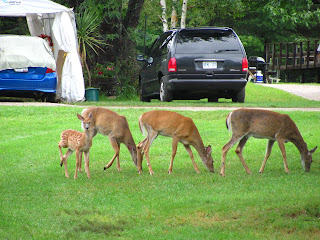
Nora and Vivian spent their last evening at Bondi fishing from the Main Dock. The girls were pulling in plenty of small fish (If you lie on the dock and lock down beneath it, you can see all these 'small fry' swishing about).
Their Dad was going back and forth between the two girls, taking the fish gently off the hooks and live-releasing them to be caught again.
Until Viv, who's only 3, caught a fish she couldn't pull up on her own.

Jamie went to assist, only to discover that not only had Vivian caught a fish, a snapping turtle had latched onto the same fish, and she had a veritable Time Machine dangling heavily from her line.
Today’s snapping turtles have hardly changed from 215 million years ago when Proganochelys, the most primitive turtle known, lived. Proganochelys had already most features of today’s turtles, although it was unable to pull its head and legs into its shell. (come to that, neither can our modern snapping turtle) In comparison the age of the dinosaurs was approximately 150 million years ago, 100 million years more recent than the first turtle. Turtles were one of the few reptile groups, which survived the impact of a six mile wide meteorite on earth and the following nuclear winter about 65 million years ago, which is known as the K-T boundary.

While the ancestor turtles were tinkering with designs of shell and size of turtle, the design of the snapping turtle as we know it today dates hasn't changed for 40 million years. These are creatures who are entitled to regard the brontosaur and mastodon as brief zoological fads. Humans have been around about 3.5 million years. Snappers are still trying to figure out "us newcomers."
When you look at one, you are getting a glimpse back into an extremely distant past. I did a
post about them last summer, when David found a young snapper across the road in need of rescue.
You have to respect these turtles -- with their heavy, pointed beaks capable of snapping off a small branch and their five massive claws on each foot, they are formidable swimmers and hunters. Luckily they are non-aggressive towards people, unless they are cornered on land or you are pestering them. In the water, around swimmers, they will just slip away. Best to just let them be. The observers thought this was a HUGE turtle... but in fact snapping turtles can weight up to 40 pounds (18 kg) and be about 14" (36 cm) long in their rough carapace. This is a younger, medium sized but still big snapping turtle.
While they do have to surface to breathe, they can rest underwater for up to four HOURS... try holding your breath, and you'll be impressed right away by this ability. They can live well over 75 years, with some reports of individuals who are well over 100. You count the rings in the shell, rather like counting tree rings, to determine age, since they continue to grow throughout their lifetime. Since they are so long lived, they don't begin to breed until they are about 19 years old. And here's a funky fact: the female can hold the sperm in her body for several seasons, so if she doesn't find a mate the following year (or years) she can still produce fertile eggs.
The greatest threat to this species is now the car -- they get hit when they come out to the edge of the roads in spring to lay their eggs. And since it is the females that are out there, getting struck by cars, this is a big concern for the population. So if you spot a turtle on the road, slow down, go around them. It would be a shame if a species whose ancestors survived the meteor strike that wiped out the dinosaurs were to succumb under the wheels of a Smartcar...
Slow down... give turtles a brake!
If you want to learn more about these amazing reptiles, the best website we've found is the
Tortoise Trust.
The female lays up to 24 eggs -- and occasionally as many as 50! in the spring, and then goes away and leaves the hidden nest and the newly hatched turtles, to fend for themselves when they hatch in 80 to 90 days' time, usually in September and October. The sex of the turtle is determined by the temperature in the nest. Below a certain temperature, the turtles will be males. Above it, females. Easy to remember, because the dudes are cool and the chicks are hot...
The dock snapper ate Vivian's fish. He then hung about under the dock and grabbed another small fish as Jamie was releasing it. Jamie dropped in a worm, and snap, that too was history.
This morning, the turtle was still there, ready for the morning fishermen to appear. He (or she? hard to tell) ate a fish right off the line that Aaron had in the water. It was all reminiscent of the Old Man and the Sea.


 crowded onto the water trampoline and raft.
crowded onto the water trampoline and raft. 



























 After all, where else you can find David, having fallen into the works of the golfcart, requiring rescue? It was an exciting few moments, when the seed tipped, and so did Dave.
After all, where else you can find David, having fallen into the works of the golfcart, requiring rescue? It was an exciting few moments, when the seed tipped, and so did Dave.






























